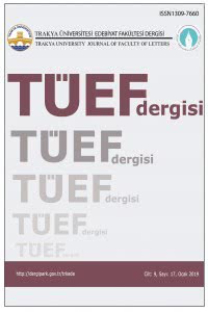İhanetin mekânından mücadele ve kurtuluşun mekânına: Nâzım Hikmet'in kuvâyi milliye şiirlerini coğrafya merkezli okuma denemesi
From the pl ace of betrayal to the place of st ruggle and salvation: The readings focused on geographic approach to the poems of kuvayi milliye by Nazim Hikmet
___
- Babayev, Ekber, Nâzım Hikmet Yaşamı ve Yapıtları, (Çev. Ataol Behramoğlu), İnkılâp Kitabevi, İstanbul 2002.
- Karaca , Alâattin, Efsane Şair Nâzım Hikmetin Kûvayi Milliye Destanına Efsanenin Dışından Bakmaya Çalışmak, Hece , (Nâzım Hikmet Özel Sayısı), S. 11, 2007, s. 185 -193.
- Kaplan, Mehmet, Edebiyat Coğrafyası, Nesillerin Ruhu, 8. bs., Dergâh Yayınları, İstanbul 2001, s. 152- 153.
- Coğrafya Merkezli Okuma, Turkish Studies , Volume 4 / 1 -I, Winter 2009, s. 423 -433.
- Kefeli, Emel, Edebiyat Coğrafyasında Akdeniz, 3 F Yayınevi, İstanbul 2006. Nâzım Hikmet, Kuvâyi Milliye , Yapı Kredi Yayınlar ı İstanbul 2002.
- Onaran, Mustafa Şerif, Kuvayi Milliye Destanı, 100. Doğum Yıldönümünde Nâzım Hikmete Armağan, T.C. Kültür Bakanlığı Yayınları, Ankara, 2002, s. 157 - 186.
- Tanzimattan Bugüne Edebiyatçılar Ansiklopedisi, 2. bs., c. II, Yapı Kredi Yayınları,İstanbul 2003.
- ISSN: 1309-7660
- Yayın Aralığı: 2
- Başlangıç: 2011
- Yayıncı: -
Yahya Kemal Ve Attilâ İlhan'ın şiirlerinde yol ve yolculuk metaforları
Kar ve buz temininde modernleşme ve xıx. yüzyıl İstanbul'unda karcı esnafı
Selçuklu dönemi resim çalışmaları
Erzurum Tortum'da önemli bir Urartu Kalesi: Kapıkaya
Kuzeybatı İran'da önemli bir yerleşme: Hasanlu
Türkçe ve Boşnakça isimlerde çokluğun kullanımı ve bunların Türkçe öğretimine etkileri
Av. Atâ Terzibaşı, Kerkük Şairleri, İstanbul: Ötüken Neşriyat, 2013, 4 Cilt, 1648 s.
